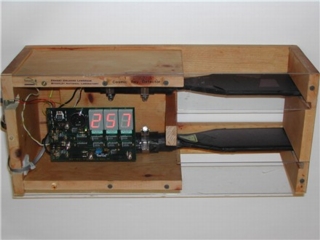The Cosmic Connection |
||||||
 |
||||||
|
Dear Howard, This is just to give you a brief status report of our use of the board you sent us. We wired it up and used it this summer with a group of 2 Quarknet lead teachers and 3 NSF RET teachers. An overflow scalar was added to allow higher counts. A description of it, and some initial data take with it can be found here. Further data has been taken with it, as we have tried to tease out something about the composition of the events we are seeing. This data is not yet posted on the web. Two further improvements were made by David Kraus, after the posting of the document above:
We had mounted both boards (LBL and 4-digit overflow board) in an aluminum chassis box with BNC connectors for the signals, so that the counters could be separated to substantial distances by adding signal cable, and data at higher rates (~1 kHz for 1 p.e.), and longer time intervals could be taken. It was necessary to use ground-isolating BNC connectors on the box to prevent a very large signal in one counter from triggering the other comparator circuit. We also varied a capacitor in the comparator network to reduce the length of the logic signal to around 50ns. The tests of photo-electron yield for those counters showed 50-100p.e./(m.i. track). HV which permits observation of 1 p.e. signals means a large dynamic range, and substantial probability of a second pulse from ions created in the cathode-1st dynode region of the PMT, which will occur within a few microseconds of the initial large pulse. This can confuse comparison of the observed cosmic ray rate with expectations. The counters have now been mounted in transparent lucite, so that they can be easily transported and also moved relative to each other with minimal risk of damage. They are now being used by Elisabeth Langford in an after school program in Southeast High School in Springfield, Illinois. I think her group may send you a report on their use later in the fall. Take Care |
||||||
|
return to more descriptions. |
||||||